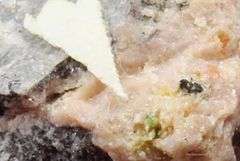Akrochordite
| Akrochordite | |
|---|---|
|
Bright green, vitreous, cluster of eveite (under 0.5 mm) and brown, subhedral akrochordite in a contrasting, pink, granular carbonate matrix | |
| General | |
| Category | Phosphate minerals |
| Formula (repeating unit) | (Mn,Mg)4(AsO4)2(OH)4.4H2O |
| Strunz classification | 8.DD.10 |
| Crystal system | Monoclinic |
| Crystal class |
Prismatic (2/m) H-M symbol: (2/m) |
| Space group | P21/c |
| Identification | |
| Color | Yellowish red-brown, pale to dark brown, pale pink |
| Cleavage | Perfect. On {010} , perfect; a second, perpendicular to the first. |
| Tenacity | Brittle |
| Mohs scale hardness | 3½ |
| Luster | Sub-Vitreous, resinous, dull |
| Diaphaneity | Translucent |
| References | [1][2][3] |
Akrochordite is an exceptionally rare hydrated hydrous arsenate mineral of the formula (Mn,Mg)4(AsO4)2(OH)4.4H2O and represents a small group of rare in the nature manganese (Mn) arsenates and, similarly to most other Mn-bearing arsenates, possess pinkish colour. It is typically associated with metamorphic Mn deposits.[2][4]
References
This article is issued from Wikipedia - version of the 11/21/2016. The text is available under the Creative Commons Attribution/Share Alike but additional terms may apply for the media files.
